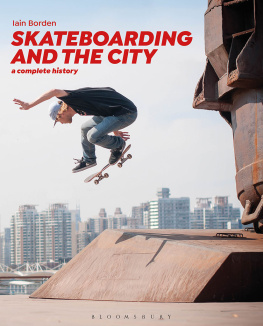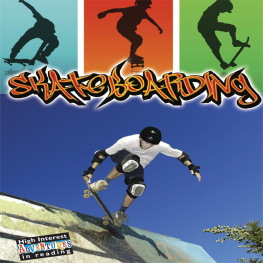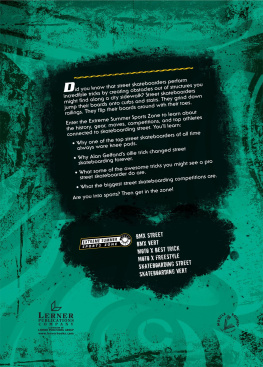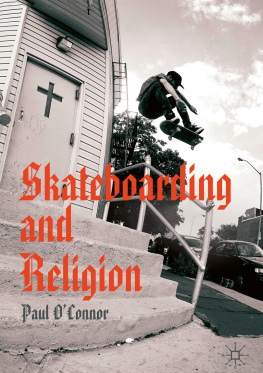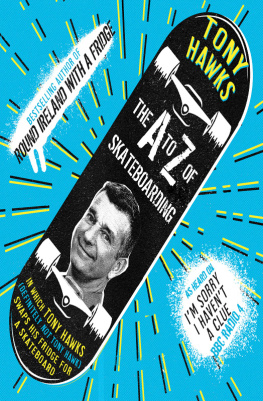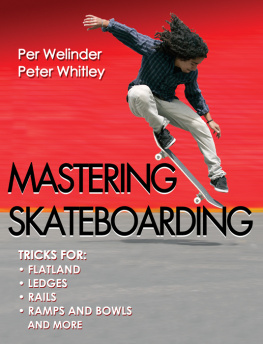SKATEBOARDING
The Ultimate Guide
Becky Beal
GREENWOOD GUIDES TO EXTREME SPORTS
Holly Thorpe and Douglas Booth, Series Editors

AN IMPRINT OF ABC-CLIO, LLC
Santa Barbara, California Denver, Colorado Oxford, England
Copyright 2013 by Becky Beal
All rights reserved. No part of this publication may be reproduced, stored in a retrieval system, or transmitted, in any form or by any means, electronic, mechanical, photocopying, recording, or otherwise, except for the inclusion of brief quotations in a review, without prior permission in writing from the publisher.
Library of Congress Cataloging-in-Publication Data
Beal, Becky.
Skateboarding : the ultimate guide / Becky Beal.
p. cm. (Greenwood guides to extreme sports)
Includes bibliographical references and index.
ISBN 9780313381126 (cloth : alk. paper) ISBN 9780313381133 (ebook) 1. Skateboarding. I. Title.
GV859.8.B4 2013
796.22dc23 2012035631
ISBN: 9780313381126
EISBN: 9780313381133
17 16 15 14 13 1 2 3 4 5
This book is also available on the World Wide Web as an eBook.
Visit www.abc-clio.com for details.
Greenwood
An Imprint of ABC-CLIO, LLC
ABC-CLIO, LLC
130 Cremona Drive, P.O. Box 1911
Santa Barbara, California 93116-1911
This book is printed on acid-free paper 
Manufactured in the United States of America
To Jennifer Sexton, my best friend and partner
series foreword
of interest to students and enthusiasts alike, extreme sports are recharging and redefining athletics around the world. While baseball, soccer, and other conventional sports typically involve teams, coaches, and an extensive set of rules, extreme sports more often place the individual in competition against nature, other persons, and himself or herself. Extreme sports have fewer rules, and coaches are less prominent. These activities are often considered to be more dangerous than conventional sports, and that element of risk adds to their appeal. They are at the cutting edge of sports and are evolving in exciting ways.
While extreme sports are fascinating in their own right, they are also a window on popular culture and contemporary social issues. Extreme sports appeal most to the young, who have the energy and daring to take part in them, and who find in them an alternative culture with its own values and vocabulary. At the same time, surfing and various other extreme sports have long histories and are important to traditional cultures around the world. The extreme versions of these sports sometimes employ enhanced technology or take place under excessively challenging conditions. Thus they build on tradition yet depart from it. Extreme sports are increasingly significant to the media, and corporations recognize the marketing value of sponsoring them. Thus extreme sports become linked with products, their star athletes become celebrities, and their fans are exposed to a range of media messages. Local governments might try to regulate skateboarding and other extreme activities, sometimes out of safety concerns and sometimes out of moral ones. Yet other communities provide funding for skateboard parks, indoor rock climbing facilities, and other venues for extreme sports enthusiasts. Thus extreme sports become part of civil discourse.
Designed for students and general readers, this series of reference books maps the world of extreme sports. Each volume looks at a particular sport and includes information about the sport's history, equipment and techniques, and important players. Volumes are written by professors or other authorities and are informative, entertaining, and engaging. Students using these books learn about sports that interest them and discover more about cultures, history, social issues, and trends. In doing so, they become better prepared to engage in critical assessments of extreme sports in particular and of society in general.
Holly Thorpe and Douglas Booth, Series Editors
preface
i started taking skateboarding seriously in the summer of 1989. I was a graduate student studying the sociology of sport when I came across a group of skateboarders who sparked my imagination and with whom I shared a similar set of values. I ended up writing my dissertation on the social worlds of skateboarders. Ever since, much of my academic research has focused on the cultural dynamics of skateboarding. Twenty-three years later, I am still engrossed in a sport that has simultaneously changed and yet stayed the same.
The ethos of skateboarding resonates with me. It's fundamentally democratic: the participants are responsible for their own growth and development as well as the development of their friends' skill sets and the activity itself. Most skaters do not rely on coaches or a rule book; instead, skateboarders are the ones who construct the activity. It's fundamentally artistic: the goal of skateboarding is to create innovative ways of moving oneself and the board through space. Skateboarders are keenly aware of rhythms, tempos, and flows while navigating different spaces. These experiences alter one's sense of self and through them, one creates a unique style. Skateboarding encourages individual interpretation and expression. Style matters.
This book is a tribute to skateboarding. One that acknowledges that it is far from a perfect sport; some groups of people have benefited much more than others from it. Additionally, there are many social forces that work against its democratic and artistic impulses. This book invites you to examine the history and culture of skateboarding so that you can use the information provided to ask critical questions about who controls skateboarding and who benefits from skateboarding as a means to envision a more humane and just physical activity.
acknowledgments
through this project i have met many passionate, generous, and dedicated people and am very grateful for their support and encouragement. Special thanks to Patty Segovia-Krause, who gave much time and energy by providing photographs, information, feedback, and professional contacts. Another special thanks to Mike Horelick, who also provided information and continuous feedback. With respect to the technology and physics chapter, I am indebted to Paul Schmitt, Mike Rafter, Conley Reed, and James Hetrick for their contributions. Thanks to Bobby Smith for contributing photographs from the 1970s, to Elizabeth Gordon for her professional contacts in the field, and to Julien Laurent for his feedback and international perspective. I appreciate the institutional support from California State UniversityEast Bay and the Department of Kinesiology. Thank you to Liem Tran for his work on the index. Finally, I want to thank editors Holly Thorpe, Doug Booth, George Butler, and Erin Ryan for their patience, support, and insightful guidance.
skateboarding timeline
1963
Larry Stevenson creates Makaha skateboards.
First organized skateboard contest is held in Hermosa Beach, CA. Sponsored by Makaha.


